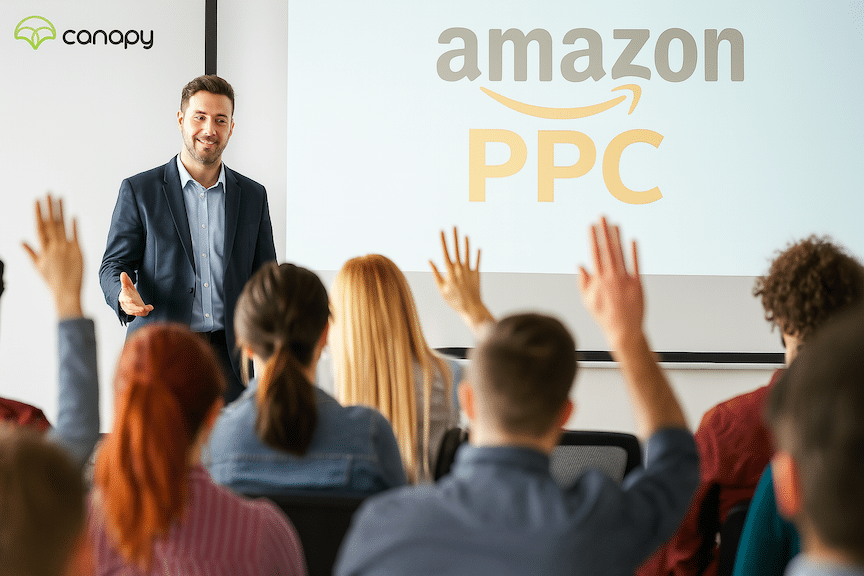The Best Amazon Advertising Strategies for 2025
Is your Amazon PPC really working for you? Use these 10 tips to lower ACoS, boost conversions, and increase sales!

As a brand entrepreneur, you’re probably well aware how competitive Amazon pay-per-click advertising has become.
Without a good Amazon advertising strategy in place you can end up wasting money you might have otherwise put into scaling your e-commerce business.
Achieving great results with your Amazon PPC ads requires more than just following the crowd and covering the basics.
Effective Amazon PPC management – everything from keyword research and Amazon Sponsored Products ads to product targeting – is crucial for success on the platform.
Key Takeaway: The 10 strategies outlined below will help push your products to the top of Amazon’s search results while maximizing your return on ad spend (ROAS).
Best Amazon Advertising Campaign Strategies for 2025
- Improve Brand Awareness
- Focus On Product Profitability
- Know Your Advertising Cost of Sales (ACoS)
- Use Negative Keywords and Phrases
- Utilize Match Types
- Optimize Your Bids
- Take Advantage of Sponsored Display Ads
- Cancel Ineffective Ad Campaigns
- Don’t Forget About Amazon DSP and Contextual Targeting
- Leverage AI for Your Amazon Listings
Ready to Start Growing Your Amazon Brand?
Canopy’s Partners Achieve an Average 84% Profit Increase!
Find out more1. Improve Awareness with a Sponsored Brands Campaign
In 2024, Amazon rolled out its low-priced “Haul” mobile shopping channel designed to compete with Shein and Temu. This will make brand building more important than ever for online entrepreneurs.
To put your brand’s Amazon Store in the spotlight, take a close look at Amazon Sponsored Brands advertising.
Why Sponsored Brands Work:
- Appear in the header’s first column of search results
- Occupy significant real estate at the top of page one on mobile
- Feature custom creative images highlighting multiple brand products
- Show a 9.5% sales conversion rate for products placed on search results pages
These ads are ideal for top-of-the-funnel brand awareness and product reach. When paired with targeted keyword phrases and exact match keywords, they become even more powerful.
2. Focus On Product Profitability
Understanding your Amazon products’ profit margins is crucial for strategic advertising decisions.
Every SKU has unique selling data points you can analyze:
- Cost to promote
- Manufacturing costs
- Selling costs
- Profit margins
Action Step: Analyze which products have higher profit margins before increasing ad spend. Dedicating resources to more profitable products helps shoppers see ASINs you’ve prioritized while improving your organic rank.
3. Know Your Advertising Cost of Sales Metrics
With Amazon’s marketplace becoming more competitive daily, the difference between profitability and wasted ad spend often comes down to pennies.
What is ACoS? Advertising Cost of Sales represents the ratio of ad spend to ad revenue, expressed as a percentage.

ACoS Formula: (Ad Spend ÷ Ad Revenue) × 100 = ACoS%
Break-even ACoS is where your advertising cost equals your profit margin (after all Amazon fees and costs).
Example Calculation:
- Profit margin: 30%
- Desired target profit margin: 12%
- Target ACoS: 18% (30% – 12%)
Important Note: A low ACoS isn’t always better. Higher ACoS may be beneficial when launching new products to maximize visibility and traffic.
Ready to Start Growing Your Amazon Brand?
Canopy’s Partners Achieve an Average 84% Profit Increase!
Find out more
4. Use Negative Keywords and Phrases
Setting up negative keywords prevents your ads from showing for irrelevant searches, which can cause:
- Wasted Ad Spend – Paying for clicks from uninterested shoppers
- Low Conversion Rates – Poor engagement hurting organic ranking
- Negative Customer Experience – Mismatched listings leading to poor reviews
Example: If selling over-the-ear headphones, add “earbuds” as a negative keyword to avoid irrelevant traffic.
Your Ultimate Goal: SELL your product, not just gather clicks.

5. Utilize Match Types
Amazon uses four match types to help advertisers refine keyword targeting:
Broad Match
- Widest net possible
- Lowest converting but drives traffic and brand awareness
- Good for discovery
Phrase Match
- More specific than broad match
- Targets customer search terms like “best red over ear headphones”
- Allows for descriptive modifiers
Exact Match
- Highly defined targeting
- Keywords must match search query exactly
- Highest conversion potential
- Example: “best red over-the-ear headphones for $100”
Negative Match
- Essential for budget optimization
- Eliminates wasteful spending
- Blocks irrelevant search terms
Ready to Start Growing Your Amazon Brand?
Canopy’s Partners Achieve an Average 84% Profit Increase!
Find out more6. Optimize Your Bids
Review keywords every few weeks to analyze effectiveness, but avoid knee-jerk reactions.
Best Practices:
- Use Automatic Targeting to discover new customer search terms
- Test new phrases before fully implementing
- Optimize for product seasonality
- Consider AI-based dynamic budget allocation
AI-Based Dynamic Budget Allocation AI tools analyze performance across multiple campaigns and allocate budgets where most effective. This ensures every dollar contributes to overall profitability.
7. Take Advantage of Amazon Sponsored Display Ads
In 2025, Sponsored Display Ads are vital for e-commerce marketing strategies.
Key Benefits:
- Target customers based on shopping behaviors (not just keywords)
- Enable precise audience targeting on and off Amazon
- Provide retargeting capabilities across platforms
- Use vCPM (cost per thousand viewable impressions) pricing
Performance Data: Sellers using Sponsored Display Ads average twice the impressions and 50% more clicks on their listings.

8. Cancel Ineffective Campaigns
Monitor campaign performance regularly and shut down underperforming ads.
Evaluation Criteria:
- Keywords not pulling their weight
- Products requiring excessive advertising for minimal sales
- Campaigns with slim return and profit margins
Decision Point: Consider discontinuing products or repositioning them as upsells rather than dedicated advertised products.
9. Don’t Forget About Amazon DSP and Contextual Targeting
Data sharing restrictions from Apple, Google, and other platforms have changed the advertising game. Amazon DSP provides invaluable first-party data access.
What is Amazon DSP? Amazon’s Demand-Side Platform enables programmatic advertising both on and off Amazon using Amazon’s first-party shopper data.
Access Options:
- Managed by Amazon (typically $50,000 minimum spend)
- Third-party agency like Canopy Management (more flexibility and control)
AI-Powered Features:
- Increased relevance and engagement
- Contextual and behavioral targeting
- Analysis of shopper behavior and preferences

10. Leverage AI for Your Amazon Listings
AI transforms Amazon advertising through creative optimization and personalized ad experiences.
Amazon’s AI Image Generation Tools
- Effortless Creation: Generate custom images with simple prompts
- Improved Engagement: Up to 40% increase in click-through rates
- Versatile Applications: Perfect for Sponsored Brands, Amazon Posts, and A/B testing
Dynamic Creative Testing
AI facilitates rapid testing of:
- Headlines for optimal messaging
- Images for maximum engagement
- Call-to-Action language for better click-through rates
Voice Search Optimization
With millions using Alexa for shopping, optimize for conversational queries:
- Focus on long-tail keywords
- Use natural, question-based phrasing
- Structure content to match voice search behavior

Frequently Asked Questions (FAQ)
What is the most important Amazon advertising strategy for 2025?
Understanding your Advertising Cost of Sales (ACoS) is fundamental. Without knowing your break-even point and target ACoS, you risk wasting ad spend on unprofitable campaigns. Calculate your profit margins first, then determine sustainable advertising costs.
How much should I spend on Amazon PPC advertising?
Your advertising budget should be based on your ACoS calculations and profit margins. Start with 10-15% of your product’s selling price for advertising, then adjust based on performance. Focus more budget on higher-margin products that can sustain advertising costs.
What’s the difference between Sponsored Products and Sponsored Brands ads?
Sponsored Products promote individual product listings and blend naturally into search results. Sponsored Brands appear at the top of search results, feature your brand logo, custom headlines, and multiple products. Use Sponsored Products for direct sales and Sponsored Brands for brand awareness.
How do I know if my Amazon ads are working?
Monitor these key metrics:
- ACoS (Advertising Cost of Sales): Should be below your break-even point
- ROAS (Return on Ad Spend): Higher ratios indicate better performance
- Conversion Rate: Percentage of clicks that result in sales
- Organic Rank Improvement: Better ad performance often improves organic visibility
Should I use automatic or manual Amazon PPC campaigns?
Start with automatic campaigns to discover which keywords Amazon’s algorithm finds relevant for your products. Once you gather data (typically 2-4 weeks), create manual campaigns using the best-performing keywords from your automatic campaigns for more control and optimization.
What are negative keywords and why are they important?
Negative keywords prevent your ads from showing for irrelevant searches. For example, if you sell “wireless headphones,” you might add “wired” as a negative keyword. This prevents wasted ad spend on clicks from shoppers looking for different products.
How often should I optimize my Amazon PPC campaigns?
Review campaign performance weekly, but make significant changes monthly. Daily micro-adjustments can hurt performance. Allow at least 7-14 days of data before making bid adjustments, and 2-4 weeks before adding or removing keywords.
What is Amazon DSP and do I need it?
Amazon DSP (Demand-Side Platform) is programmatic advertising that reaches customers on and off Amazon using Amazon’s first-party data. It’s beneficial for larger brands with bigger budgets (typically $50,000+ monthly ad spend) focused on brand awareness and retargeting.
How can AI help with my Amazon advertising?
AI assists with:
- Creative optimization: Generating and testing ad images and copy
- Bid management: Automatically adjusting bids based on performance
- Audience targeting: Finding similar customers based on purchasing behavior
- Budget allocation: Moving money to best-performing campaigns
What’s the best match type for Amazon PPC keywords?
Use a combination:
- Broad match: For discovery and gathering data
- Phrase match: For targeted traffic with some flexibility
- Exact match: For your highest-converting, most profitable keywords Start broad, then move successful keywords to more restrictive match types for better control.
How do I optimize for voice search on Amazon?
Focus on natural, conversational keywords that people speak rather than type. Instead of “bluetooth headphones,” target “what are the best bluetooth headphones for working out.” Optimize product titles and descriptions to answer common questions customers ask Alexa.
When should I cancel an Amazon advertising campaign?
Cancel campaigns that:
- Consistently exceed your target ACoS without improving organic rank
- Generate clicks but no sales after 30+ days
- Promote products with profit margins too low to sustain advertising costs
- Target keywords completely irrelevant to your product
How Canopy Management Can Help
Canopy Management can help you build the best Amazon advertising strategy that aligns with your unique business needs. We’ll help you get more from your marketing budget so you can do more for your business.
If you’d like to give yourself the same advantage that many of Amazon’s top brands have used to dominate their niche, reach out to the team at Canopy Management.
Canopy Management is a full-service marketing agency for Amazon, Walmart, and TikTok sellers. Our team consists of multi-million dollar, omni-channel entrepreneurs, industry leaders, and award-winning experts.


